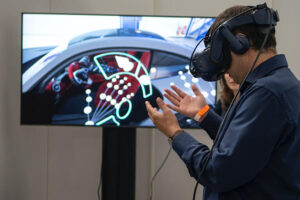 At four recent VR conferences and events there was a palpable sense that despite new home VR devices getting the majority of marketing and media attention this year, the immediate promise and momentum is in the location-based VR (LBVR) attractions industry. The VR Arcade Conference (April 29th and 30th), VRLA (May 4th and 5th), the Digital Entertainment Group’s May meeting (May 1), and FoIL (Future of Immersive Leisure, May 16th and 17th) all highlighted a topic that suddenly no one can stop talking about: location-based VR (LBVR). With hungry landlords giving great deals for empty retail locations, VRcades, which are inexpensive to open (like Internet Cafes), are popping up all over the country. As a result, VRcade royalties for developers are on the rise, so they are shifting their attention accordingly to shorter experiences optimized for LBVR, which is much less expensive than building a VR app for the home.
At four recent VR conferences and events there was a palpable sense that despite new home VR devices getting the majority of marketing and media attention this year, the immediate promise and momentum is in the location-based VR (LBVR) attractions industry. The VR Arcade Conference (April 29th and 30th), VRLA (May 4th and 5th), the Digital Entertainment Group’s May meeting (May 1), and FoIL (Future of Immersive Leisure, May 16th and 17th) all highlighted a topic that suddenly no one can stop talking about: location-based VR (LBVR). With hungry landlords giving great deals for empty retail locations, VRcades, which are inexpensive to open (like Internet Cafes), are popping up all over the country. As a result, VRcade royalties for developers are on the rise, so they are shifting their attention accordingly to shorter experiences optimized for LBVR, which is much less expensive than building a VR app for the home.
The optimism around LBVR is about to be tested as high-end VR attractions like The VOID, and large-scale international attractions like Oriental Science Fiction Valley, which opened April 29th, 2018 in the southwestern province of Guizhou, China, open to the public. VRBars and humble VRCades are opening in the Americas by the hundreds. There are reportedly over 3,000 such locations in China already. Two Bit Circus is imminently opening its downtown-LA attraction, a full-service bar & restaurant which offers an array of VR experiences and casual entertainment like robot bartenders. More expensive, high-end free roam installations from VRStudios, Zero Latency, The VOID, Dreamscape Immersive, Nomadic, FoxNext, Pure Imagination, Tick Tock Unlock (UK), Backlight (France), HADO (Singapore), Battleverse (Toronto) and the newly announced Figment, have dozens of openings planned between them this year. At the same time Family Entertainment Centers (FEC’s), and Adult Entertainment Centers (AEC’s), hungry for high revenue cutting-edge VR, are snapping up smaller VR installations like Hologate and WePlayVR (from AiSolve), which are optimized for their operating environments. Alexis Macklin, of Greenlight Insights, says the global location-based VR entertainment market will more than double in 2018, to $1.2 billion, and will grow to over $8 billion by the end of 2022.

Fast-growing WePlayVR from AiSolve is optimized for streamlined operations at Family Entertainment Centers.
“Hollywood is suddenly focused on the out-of-home VR market because adoption of VR in the home market has been slow. With low adoption comes low revenue. However, VR content creators, many of whom are Hollywood storytellers, artists, and designers, want to keep creating content. As a result, LBVR is now seen as a viable outlet for new VR experiences,” said Shauna Heller, head of North American operations for AiSolve, which has dozens of installations of its small footprint free roam VR attraction in the market, optimized for FEC’s, which measure success by revenue per square foot. Bruce Vaughn, CEO of Dreamscape Immersive said at FOiL that “the complete immersion of VR is a storyteller’s dream. It is the ultimate platform for escapism. That’s our industry. Of course, we want to find the sweet spot of cinema, game mechanics, and theme park attractions. Unlock that in a way that’s available in every home and you will be very successful.”

Hologate combines four Vive room scale set ups to create multi-player experiences.
Leif Petersen, founder, and CEO of Hologate, a four-station Vive room scale system for FEC’s that is tethered (i.e. virtually free roam), told me the company is on track to open 90 locations this year, bringing their total install to 150 by year’s end. Hologate now has 60 locations which serve 100,000 customers every month.
VRStudios, founded in 2014, is one of the established leaders in high-end free roam LBVR. The company does not operate its own locations, though it has 57 installations in 14 countries, mostly in theme parks like Universal Studios and Knott’s Berry Farm. The company just introduced a small (10’x10’) turnkey free roam VR system much like WePlayVR, called the VRcade Atom. “Atom is a true commercial-grade, wireless free-roaming system, and its price point makes it compelling for LBEs to drop the wires and add VR attractions to their business,” said Kevin Vitale, VRstudios’ CEO. At the same time, VRStudios is developing a multiplayer free roam sports-based VR experience with high repeatability for its clients and is contemplating its own retail venues.
Vitale says the Atom system is very cost effective, easy to install and efficient to operate. Atoms have a small footprint and, like the other VRcade systems, do not require expensive facility changes or construction. It’s a turnkey system that includes everything an LBE needs to add room-scale, free-roaming, multiplayer VR attractions to their attractions.

















